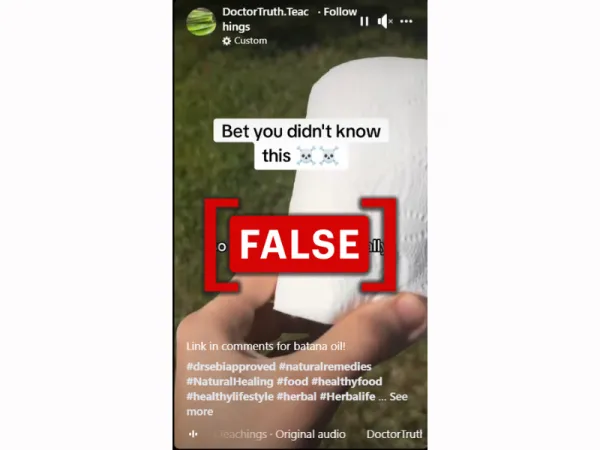By: Kari Nixon
July 11 2024
 A post circulating on Facebook claims the bleaching process in toilet paper production contributes to PFAS in the final product at levels harmful to humans..
A post circulating on Facebook claims the bleaching process in toilet paper production contributes to PFAS in the final product at levels harmful to humans..
The bleaching process in toilet paper production is similar to any other cleansing process using bleach at safe levels for humans.
The claim
On July 5, a post began circulating on Facebook claiming that the bleaching process in toilet paper causes it to harbor “harmful chemicals," such as poly-fluoroalkyl substances (PFAS). Instead, the speaker in the video recommends the use of bamboo toilet paper. As of July 10, this post had amassed 2.1 million views and 24,700 likes.
However, the bleaching process in toilet paper production is similar to any other cleansing process using bleach at safe levels for humans, and while toilet paper does contain PFAS, these amounts are considered very low.
In fact
The production chain of toilet paper first involves breaking large pieces of wood into chips. These chips are then further broken down in “decomposer” tanks which cook the wood at high temperatures in a mixture of water, sodium hydroxide, and sodium sulfide to break the wood down into a semi-liquid substance known as pulp. This pulp mixture is then bleached to remove any remaining impurities that might otherwise be transferred to the consumer.
We contacted experts to clarify the matter. According to Richard Venditti, Endowed Chair Professor of Forest Biomaterials, Paper Science and Engineering at North Carolina State University, “the bleaching chemicals are not toxic to humans.” Instead, he explains, “the chlorine in the bleaching chemicals is similar to the chlorine we use to disinfect drinking water and swimming pools."
Studies of pulp mills and their byproducts do sometimes assess the effects of effluents (wastewater) of this process on fish, but the study of this impact is not equivalent to assessing the use of bleach for contamination in human drinking water (or toilet paper), which is more controlled in its dilution for the specific purpose of decontamination.
No study appears to exist examining the toxicity of the bleaching process on the resultant paper product, suggesting that the majority of the scientific community agrees with Venditti that the bleaching process's effect upon the paper is one of cleansing, not contamination.
Addressing the PFAS claims from the social media post, Venditti added, "PFAS have nothing to do with the bleaching” process. Indeed, we found no scientific studies that connected toilet paper’s PFAS levels to its impact on human health. While toilet paper does contain PFAS, these amounts are considered very low. A much-touted study (featured in The Guardian and Time) that gained significant media hype in 2013 did find that discarded toilet paper (i.e., not just that created in the production process) could contribute to PFAS levels in water. However, even The Guardian’s coverage included notable experts from environmental agencies who said not to use these findings as reasons to “stop using or reduce the amount of toilet paper they use."
Indeed, the CDC does not list touch-based contact with PFAS on its list of exposure concerns for PFAS. Moreover, blood levels of Americans tested for PFAS exposure have shown a 70 percent decrease in blood levels of PFOS and PFOA (two types of PFAS) since 2000.
Subsequent to the hype around this study, the American Chemical Society drafted a press release clarifying its findings. They explained that, in fact, the study’s comparison of PFAS levels in the water of different countries that differ in their rates of toilet paper usage revealed less PFAS in North America, even though North America uses more toilet paper than many other countries. This actually suggests that at least in the U.S., “most PFAS enter the…wastewater systems from cosmetics, textiles, food packaging or other sources."
The verdict
The bleaching process of toilet paper is associated with decontamination techniques and does not, therefore, contaminate the paper product. While the bleaching process could be an environmental concern, it is unrelated to PFAS found in water, which seems to be only very weakly affected by toilet paper, if at all. Therefore, we have marked this claim as false.